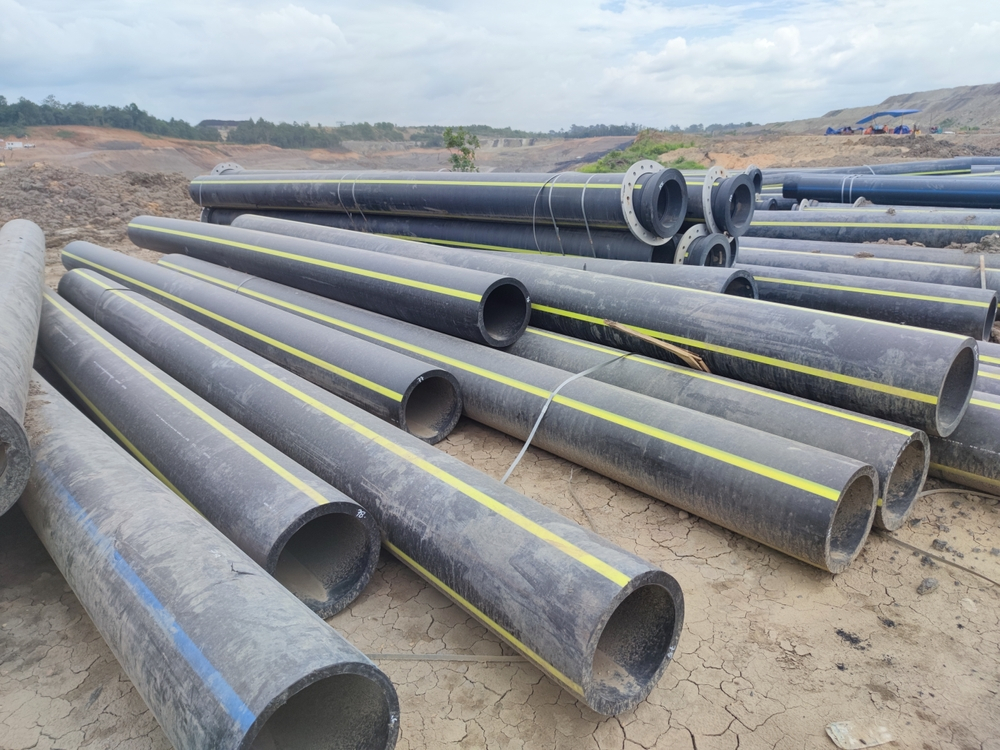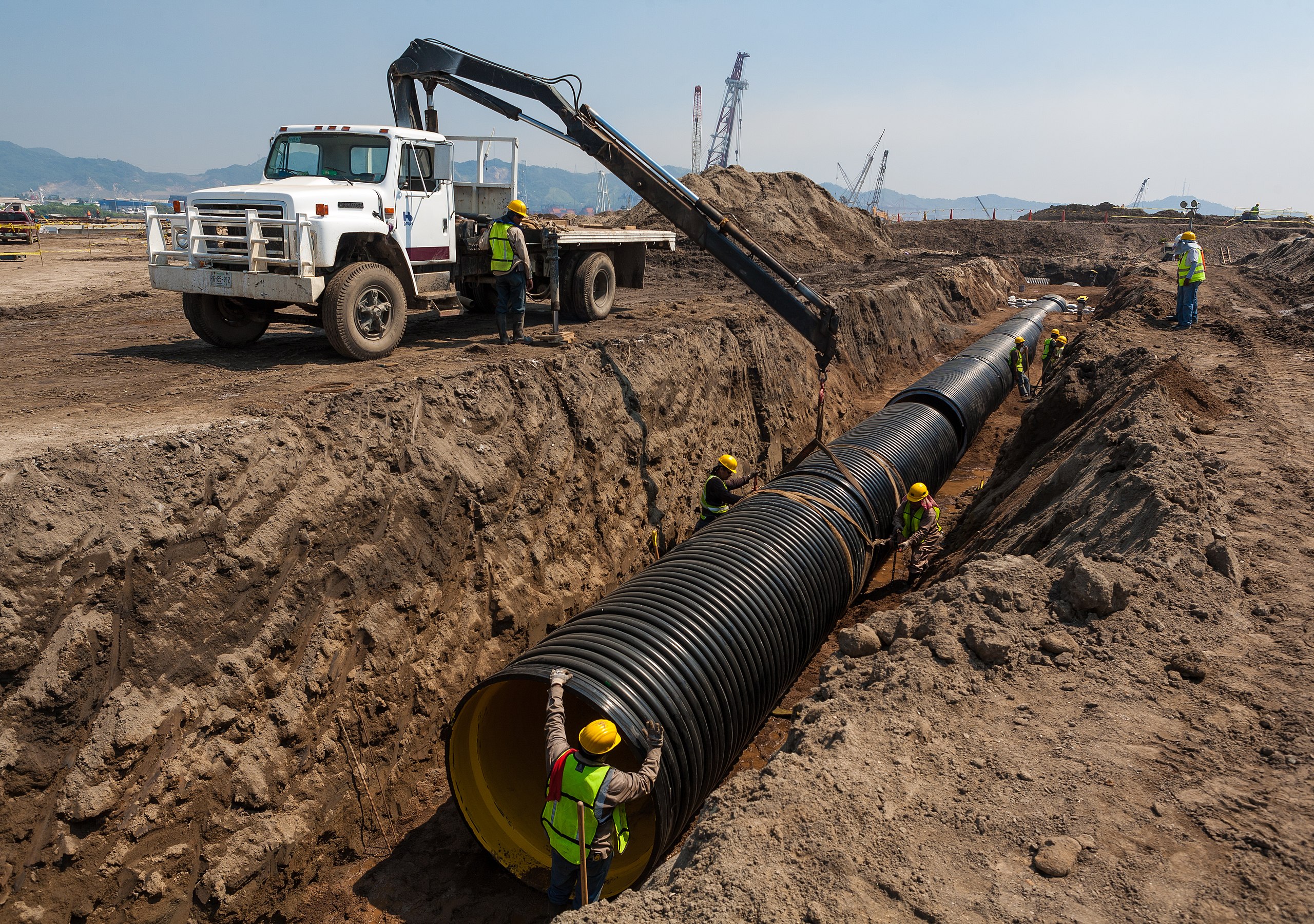Exploring American Plastics HDPE Pipe Manufacturing and Its Impact in Modern Infrastructure
Wiki Article
Discover the Production Process Behind High-Quality HDPE Pipeline and Its Applications
The manufacturing procedure of high-grade HDPE pipes is elaborate and systematic. It starts with the selection of basic materials that enhance efficiency. Following this, ethylene goes through polymerization to create material, which is after that shaped via extrusion. Quality assurance is extremely important, ensuring that the end product meets rigorous criteria. Nonetheless, the journey of HDPE pipes does not end with production. Their applications across various markets expose a more comprehensive relevance worth analyzing.Comprehending HDPE: Residences and Advantages

High-density polyethylene (HDPE) is a flexible polycarbonate understood for its toughness and resistance to different ecological elements. This product shows outstanding tensile toughness, making it ideal for demanding applications. Its low-density framework adds to a light-weight item, facilitating simplicity of managing and setup. HDPE additionally showcases impressive resistance to chemicals, which lessens destruction when exposed to rough materials.
The material's reduced wetness absorption even more enhances its long life, making it ideal for use in pipes and storage space tanks. Furthermore, HDPE is resistant to ultraviolet (UV) radiation, ensuring that products maintain their integrity even when subjected to sunshine. Its versatility enables for the production of intricate forms without compromising strength. The eco-friendly nature of HDPE, commonly derived from recycled materials, adds to its allure, promoting sustainable methods in manufacturing. Overall, these buildings and advantages make HDPE a recommended selection for different commercial and consumer applications.
Raw Material Selection for HDPE Production
The selection of raw materials for HDPE production is important to confirm the end product satisfies the preferred requirements and high quality standards. High-density polyethylene (HDPE) is mostly generated from polymerized ethylene, acquired from nonrenewable fuel sources such as gas or petroleum. The top quality of these feedstocks considerably influences the mechanical and thermal residential or commercial properties of the last HDPE.Additives likewise play a considerable duty in enhancing HDPE's performance, consisting of anti-oxidants, UV stabilizers, and colorants, which improve resilience and resistance to ecological variables. The option procedure must think about not just the chemical structure of the raw products yet additionally their handling features to ensure reliable manufacturing.
Additionally, the sourcing of raw materials should prioritize sustainability and compliance with environmental policies, as responsible methods are critical in today's market. Eventually, careful raw product choice lays the foundation for creating high-grade HDPE pipelines suitable for varied applications.
The Extrusion Process: Forming HDPE Pipeline
The extrusion procedure plays an essential duty fit HDPE pipes, beginning with thorough product preparation strategies that ensure suitable flow and consistency. Equally important is the layout of the die, which directly affects the last measurements and surface area high quality of the pipeline. Together, these elements add considerably to the effectiveness and top quality of HDPE pipeline manufacturing.Material Preparation Methods
Effective production of HDPE pipelines starts with precise product prep work techniques, especially the extrusion process. During this stage, high-density polyethylene material is initial dried to eliminate moisture, making sure perfect circulation qualities. The resin is then fed into the extruder, where it undertakes home heating and melting, changing into a thick state. This home heating process is thoroughly regulated to keep the product's integrity and performance. The liquified HDPE is forced through a die, forming it right into a continual pipe form. Correct temperature level administration throughout extrusion is crucial, as it directly impacts the product's residential properties and the last item high quality. As soon as formed, the HDPE pipeline is cooled and cut to specified lengths, ready for succeeding this handling and applications.Die Design Relevance
Accuracy in die layout plays a vital function in the extrusion procedure of HDPE pipes. The die functions as the last shaping tool, directly influencing the pipe's dimensions, wall thickness, and surface finish. A properly designed die replace water line to house warranties consistent material flow, reducing defects such as irregularities and weak areas. The geometry of the die need to be optimized to fit the specific properties of HDPE, including its thickness and thermal habits throughout extrusion. In addition, the cooling rate of the material as it travels through the die can significantly affect the pipe's architectural stability. Consequently, investing in sophisticated die modern technology is important for manufacturers intending to produce top notch HDPE pipes that satisfy market criteria and client expectations.Top Quality Control Procedures in HDPE Production
Various variables influence the quality of HDPE pipe production, reliable top quality control actions are important to ensure uniformity and dependability in the last product (Pipe Supplier American Plastics Midland). Secret top quality control practices consist of strenuous material examination, confirming that the raw polyethylene fulfills well established standards for pureness and thickness. Throughout the extrusion process, parameters such as temperature level, stress, and cooling time are closely monitored to maintain dimensional precision and structural integrityAdditionally, post-production screening is crucial; manufacturers often perform hydrostatic examinations to evaluate the pipeline's strength and resistance to pressure. Visual inspections for surface area issues additionally improve quality control. Accreditation from pertinent standards companies, like ASTM or ISO, supplies an added layer of integrity. By executing these extensive quality assurance actions, producers can reduce problems, improve efficiency, and guarantee that the HDPE pipelines meet the particular requirements of various applications, ultimately causing customer fulfillment and count on the product.
Applications of HDPE Pipeline Throughout Industries
HDPE pipelines are utilized across different industries as a result of their longevity and convenience. In water distribution systems, they ensure effective distribution, while in wastewater management, they supply reliable services for waste transportation. Furthermore, agricultural irrigation networks gain from HDPE's resistance to deterioration and adaptability, making it a suitable option for contemporary farming practices.
Water Circulation Systems
A considerable number of industries depend on high-density polyethylene (HDPE) pipes for reliable water circulation systems. Known for their durability and resistance to rust, HDPE pipes are commonly utilized in local water system networks, farming watering, and commercial applications. Their lightweight nature helps with easy handling and setup, lowering labor costs and time. In addition, HDPE pipes can suit various pressure levels, making them suitable for both low and high-pressure systems. American Plastics HDPE Pipe Manufacturing. The adaptability of the material enables seamless assimilation into existing facilities, lessening the demand for considerable excavation. HDPE's resistance to chemical leaching assurances that the water provided stays risk-free and clean, making it an excellent option for keeping the quality of safe and clean water across various industries.Wastewater Monitoring Solutions
Effective water circulation systems additionally lead the means for cutting-edge wastewater monitoring remedies, where high-density polyethylene (HDPE) pipes play a considerable function. Distinguished for their longevity and resistance to deterioration, HDPE pipes are ideal for delivering wastewater in numerous settings. Their versatility permits her explanation for easy installation in complex environments, decreasing the need for substantial excavation. Additionally, HDPE's smooth interior surface area lowers friction, boosting circulation prices and performance. These pipelines are additionally immune to chemical leaching, guaranteeing that impurities do not jeopardize the surrounding environment. Industries, communities, and treatment facilities significantly rely upon HDPE pipelines for their reliability and long life, making them a favored selection for modern wastewater administration systems. This flexibility highlights the vital importance of HDPE pipelines throughout countless applications.Agricultural Watering Networks
Agricultural irrigation networks profit substantially from using high-density polyethylene (HDPE) pipelines, which offer effective and reliable water delivery to crops. HDPE pipes are lightweight, making them very easy to deliver and set up, while their adaptability enables different arrangements in diverse terrains. These pipelines show exceptional resistance to corrosion, chemicals, and UV radiation, making sure durability in extreme farming environments. Additionally, their smooth indoor surface minimizes rubbing loss, maximizing water flow and reducing power expenses connected with pumping. The durability of HDPE pipes, usually exceeding 50 years, adds to decrease maintenance and substitute expenditures. Farmers significantly rely on HDPE pipelines to enhance irrigation effectiveness and promote lasting farming techniques, eventually leading to boosted plant yields and source preservation.
Future Trends in HDPE Pipeline Technology
As the demand for lasting and efficient infrastructure expands, innovations in HDPE pipeline technology are positioned to transform different markets. Emerging fads consist of the assimilation of clever technologies, such as sensing units and IoT capabilities, which promote real-time tracking of pipeline problems, decreasing upkeep expenses and preventing leakages. In addition, the development of sophisticated manufacturing strategies, such as 3D printing, is making it possible for the manufacturing of complex, personalized pipe layouts that cater to certain project needs.Furthermore, the concentrate on recycling and circular economic climate techniques is driving the innovation of HDPE pipelines made from recycled products, enhancing sustainability. Improved jointing methods, such as electro-fusion and mechanical installations, are also enhancing installment effectiveness and integrity. Ultimately, the growing emphasis on environmental guidelines is pressing manufacturers to adopt greener manufacturing processes, guaranteeing that HDPE pipelines not just meet industry requirements however additionally cultivate an even more sustainable future for framework advancement.
Regularly Asked Concerns
Exactly How Does HDPE Contrast to Other Plastic Products?
HDPE outshines numerous other plastic materials concerning resilience, chemical resistance, and versatility. Its low density and high tensile toughness make it perfect for different applications, usually going beyond choices in both efficiency and long life.What Are the Environmental Influences of HDPE Production?
The environmental influences of HDPE production consist of greenhouse gas emissions, power consumption, and possible pollution from producing processes. Additionally, incorrect disposal can cause dirt and water contamination, increasing problems regarding long-term environmental impacts.Can HDPE Pipeline Be Reused?
Yes, HDPE pipes can be recycled. Numerous facilities approve utilized HDPE for processing, transforming it into brand-new products. This recycling adds to sustainability efforts, minimizing plastic waste while saving resources and power in the production cycle.What Is the Lifespan of HDPE Piping?

Exactly How Do Temperature Level Variations Influence HDPE Pipeline Efficiency?
Temperature level variants substantially affect HDPE pipeline efficiency, affecting flexibility and strength. Heats can bring about softening, while low temperatures might cause brittleness, eventually influencing the pipe's longevity and viability for numerous applications in varied settings.Report this wiki page